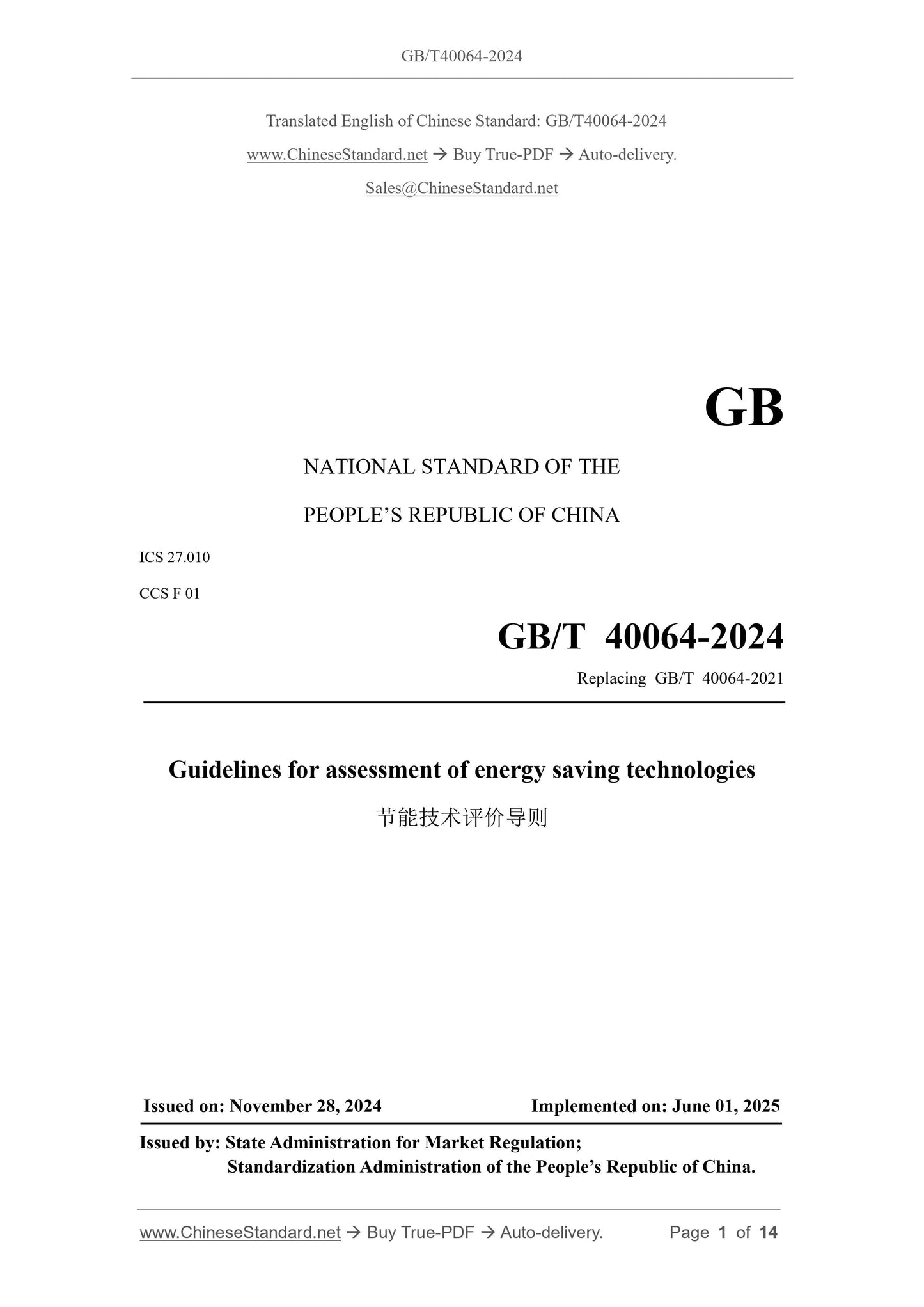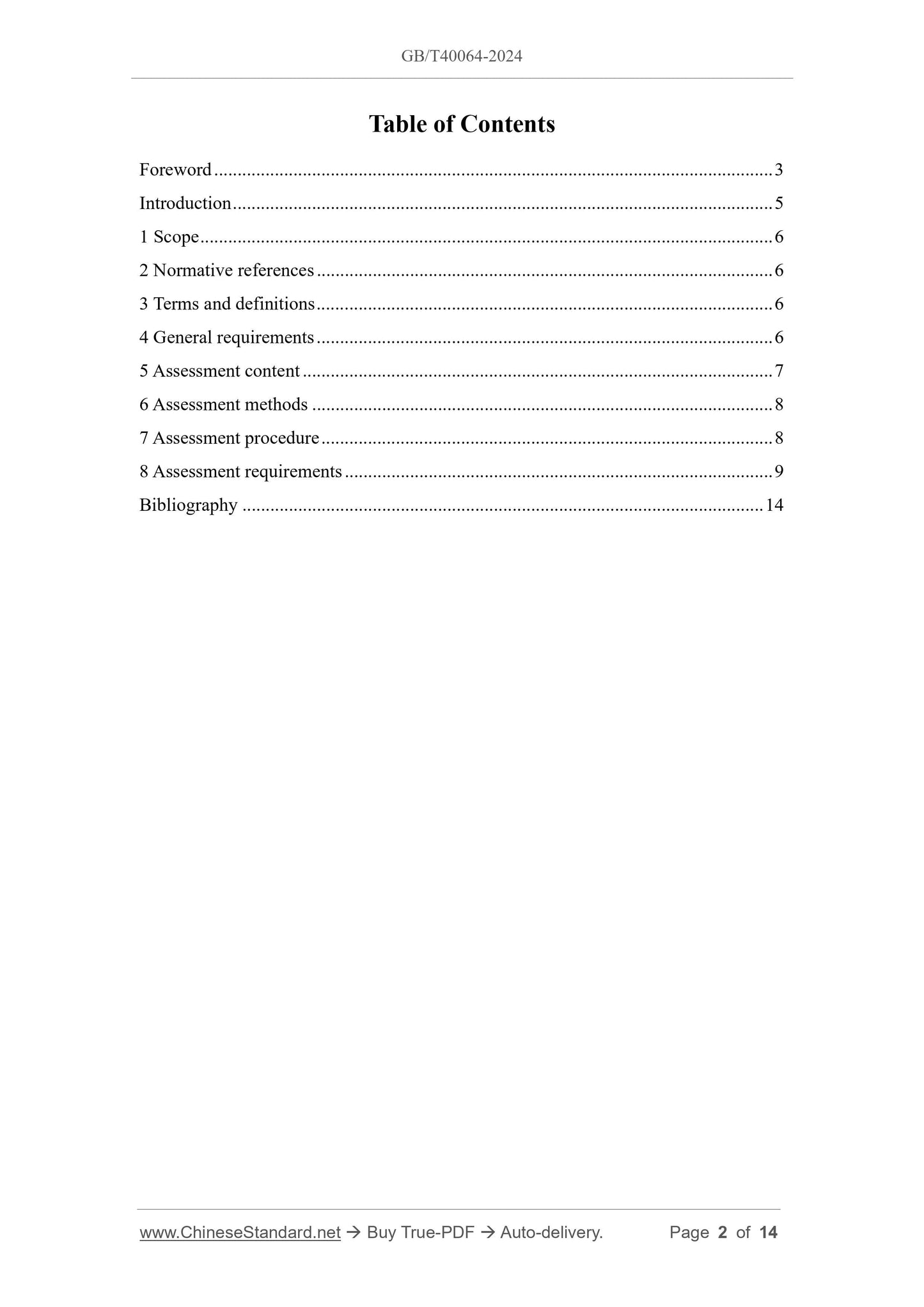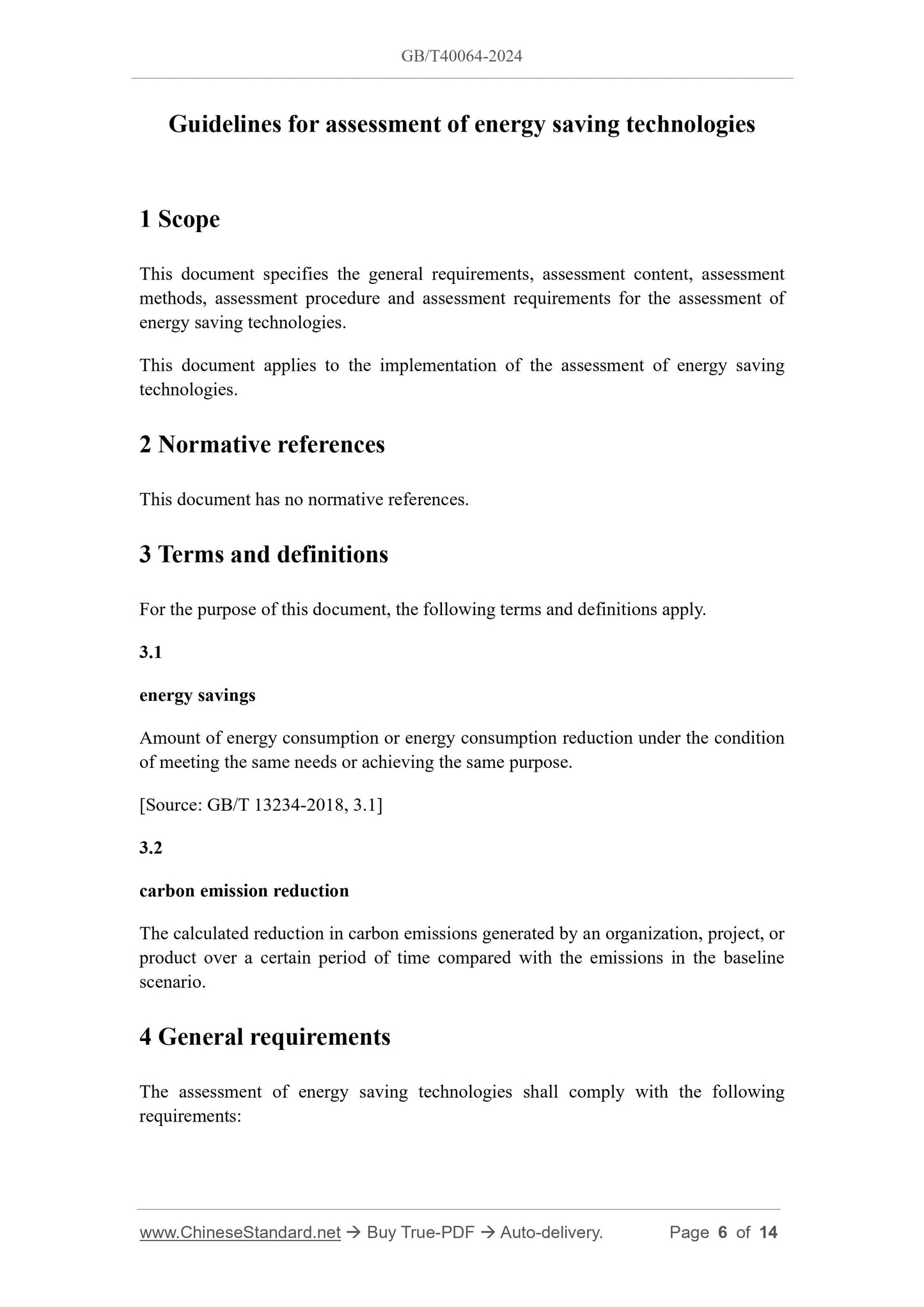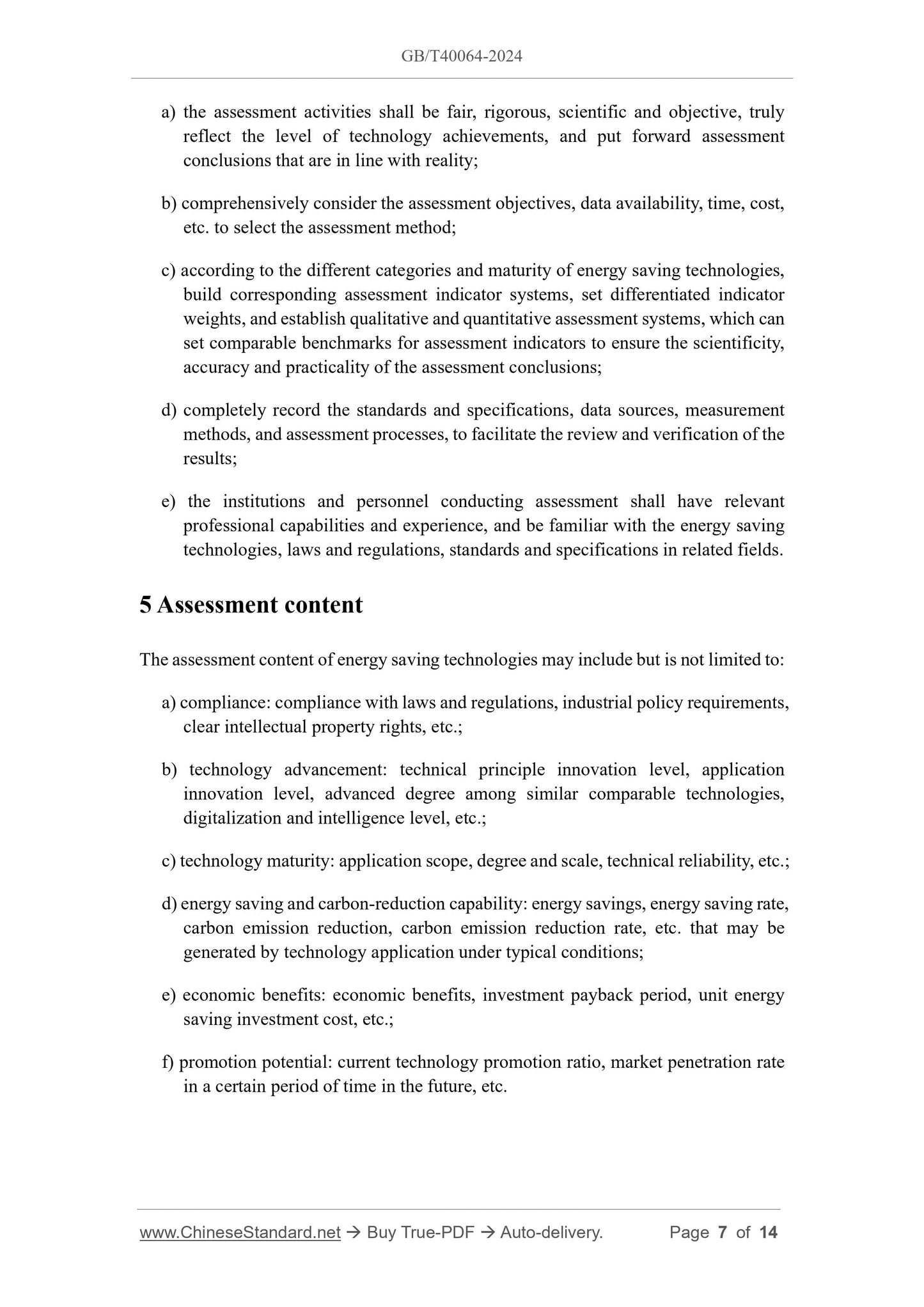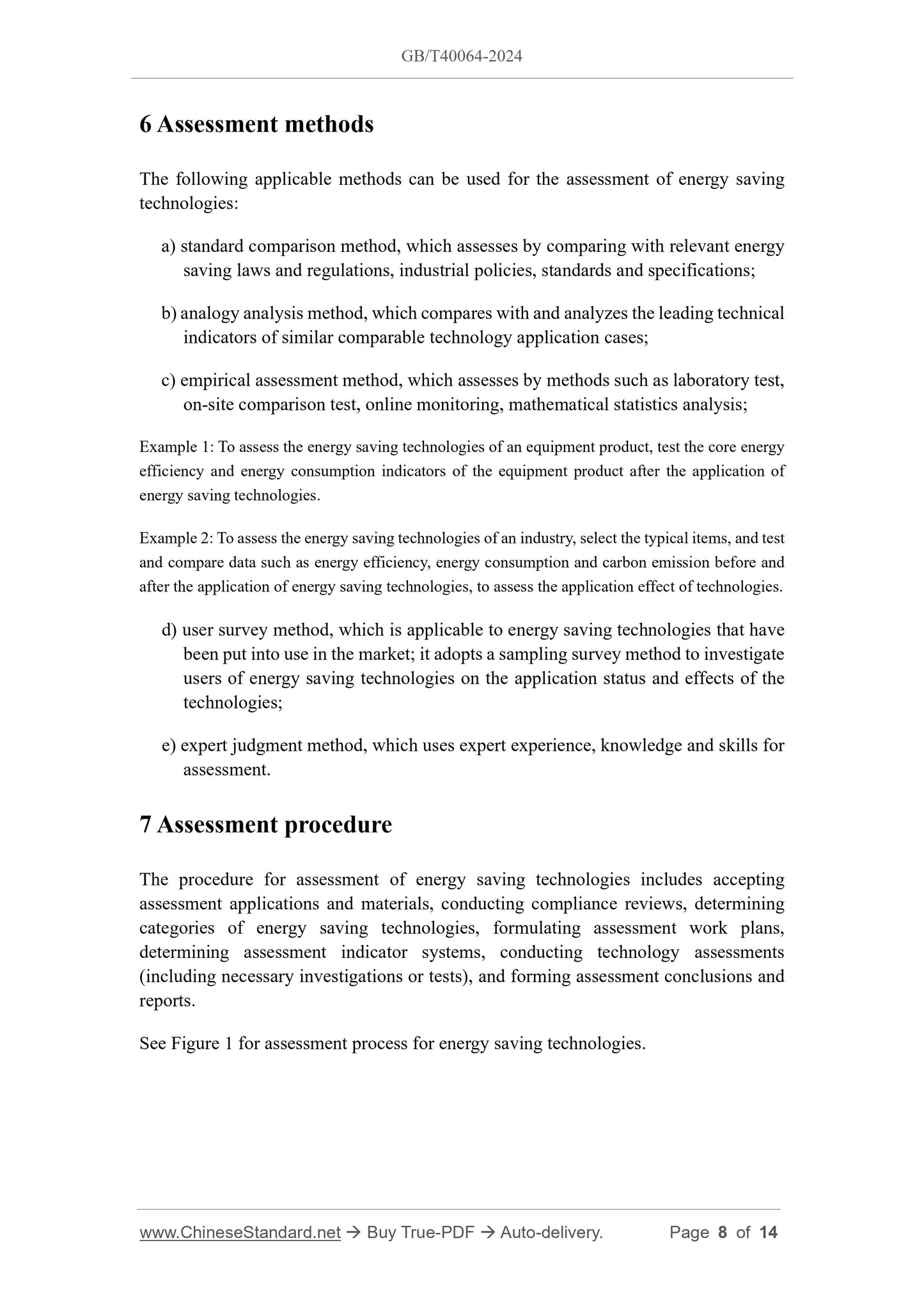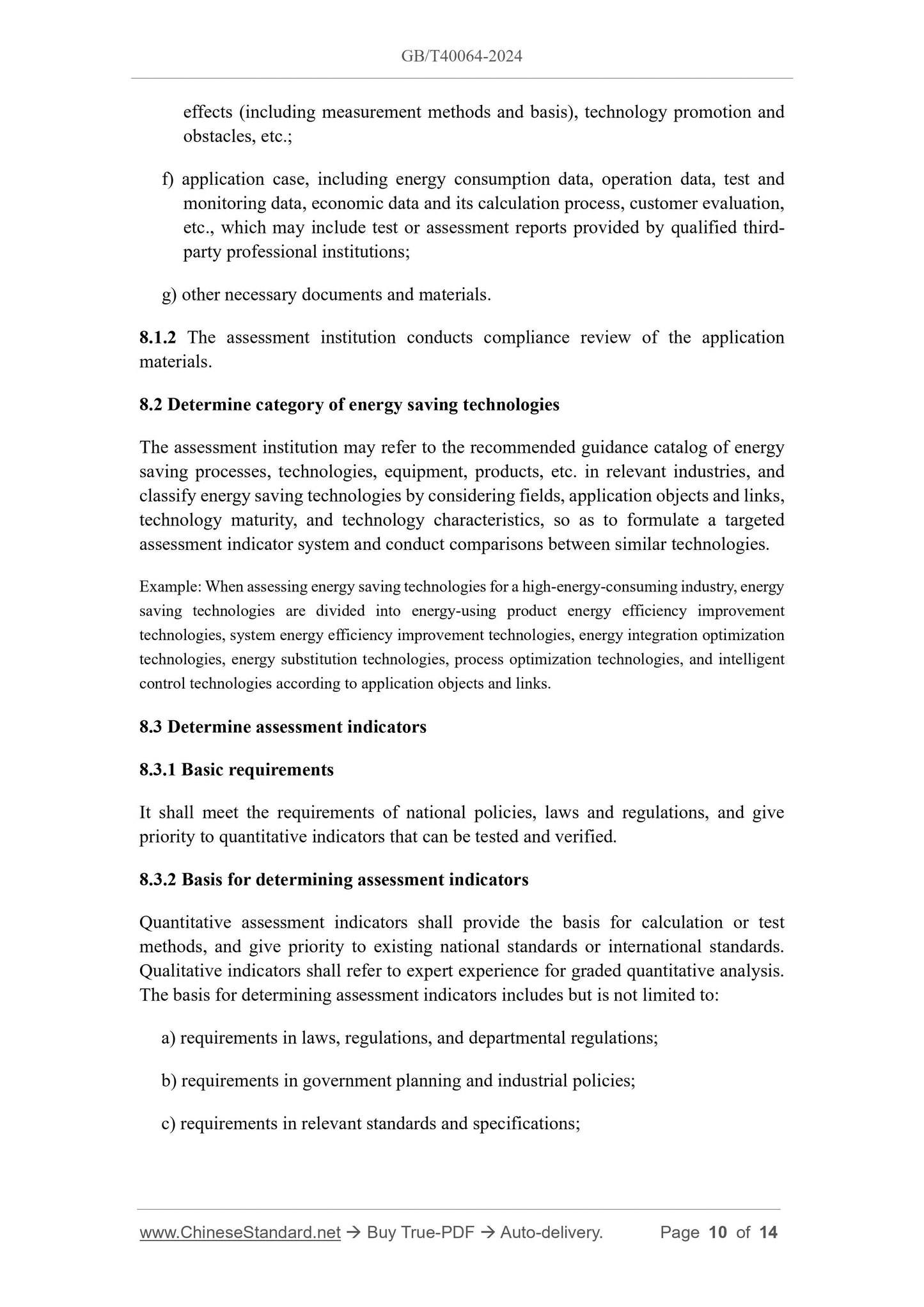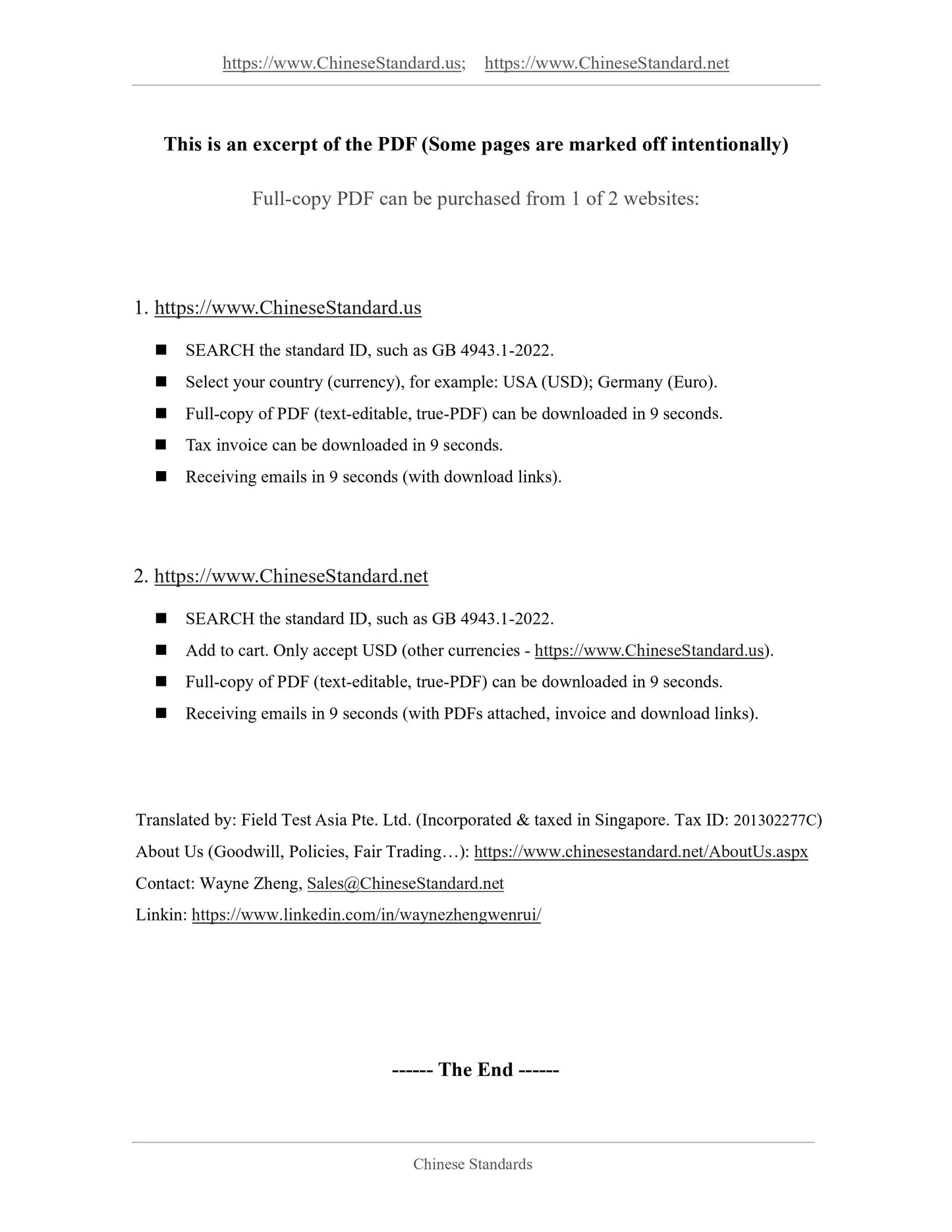1
/
of
7
www.ChineseStandard.us -- Field Test Asia Pte. Ltd.
GB/T 40064-2024 English PDF (GB/T40064-2024)
GB/T 40064-2024 English PDF (GB/T40064-2024)
Regular price
$275.00
Regular price
Sale price
$275.00
Unit price
/
per
Shipping calculated at checkout.
Couldn't load pickup availability
GB/T 40064-2024: Guidelines for assessment of energy saving technologies
Delivery: 9 seconds. Download (& Email) true-PDF + Invoice.
Get Quotation: Click GB/T 40064-2024 (Self-service in 1-minute)
Historical versions (Master-website): GB/T 40064-2024
Preview True-PDF (Reload/Scroll-down if blank)
GB/T 40064-2024
GB
NATIONAL STANDARD OF THE
PEOPLE’S REPUBLIC OF CHINA
ICS 27.010
CCS F 01
GB/T 40064-2024
Replacing GB/T 40064-2021
Guidelines for assessment of energy saving technologies
ISSUED ON. NOVEMBER 28, 2024
IMPLEMENTED ON. JUNE 01, 2025
Issued by. State Administration for Market Regulation;
Standardization Administration of the People’s Republic of China.
Table of Contents
Foreword... 3
Introduction... 5
1 Scope... 6
2 Normative references... 6
3 Terms and definitions... 6
4 General requirements... 6
5 Assessment content... 7
6 Assessment methods... 8
7 Assessment procedure... 8
8 Assessment requirements... 9
Bibliography... 14
Guidelines for assessment of energy saving technologies
1 Scope
This document specifies the general requirements, assessment content, assessment
methods, assessment procedure and assessment requirements for the assessment of
energy saving technologies.
This document applies to the implementation of the assessment of energy saving
technologies.
2 Normative references
This document has no normative references.
3 Terms and definitions
For the purpose of this document, the following terms and definitions apply.
3.1
energy savings
Amount of energy consumption or energy consumption reduction under the condition
of meeting the same needs or achieving the same purpose.
[Source. GB/T 13234-2018, 3.1]
3.2
carbon emission reduction
The calculated reduction in carbon emissions generated by an organization, project, or
product over a certain period of time compared with the emissions in the baseline
scenario.
4 General requirements
The assessment of energy saving technologies shall comply with the following
requirements.
a) the assessment activities shall be fair, rigorous, scientific and objective, truly
reflect the level of technology achievements, and put forward assessment
conclusions that are in line with reality;
b) comprehensively consider the assessment objectives, data availability, time, cost,
etc. to select the assessment method;
c) according to the different categories and maturity of energy saving technologies,
build corresponding assessment indicator systems, set differentiated indicator
weights, and establish qualitative and quantitative assessment systems, which can
set comparable benchmarks for assessment indicators to ensure the scientificity,
accuracy and practicality of the assessment conclusions;
d) completely record the standards and specifications, data sources, measurement
methods, and assessment processes, to facilitate the review and verification of the
results;
e) the institutions and personnel conducting assessment shall have relevant
professional capabilities and experience, and be familiar with the energy saving
technologies, laws and regulations, standards and specifications in related fields.
5 Assessment content
The assessment content of energy saving technologies may include but is not limited to.
a) compliance. compliance with laws and regulations, industrial policy requirements,
clear intellectual property rights, etc.;
b) technology advancement. technical principle innovation level, application
innovation level, advanced degree among similar comparable technologies,
digitalization and intelligence level, etc.;
c) technology maturity. application scope, degree and scale, technical reliability, etc.;
d) energy saving and carbon-reduction capability. energy savings, energy saving rate,
carbon emission reduction, carbon emission reduction rate, etc. that may be
generated by technology application under typical conditions;
e) economic benefits. economic benefits, investment payback period, unit energy
saving investment cost, etc.;
f) promotion potential. current technology promotion ratio, market penetration rate
in a certain period of time in the future, etc.
6 Assessment methods
The following applicable methods can be used for the assessment of energy saving
technologies.
a) standard comparison method, which assesses by comparing with relevant energy
saving laws and regulations, industrial policies, standards and specifications;
b) analogy analysis method, which compares with and analyzes the leading technical
indicators of similar comparable technology application cases;
c) empirical assessment method, which assesses by methods such as laboratory test,
on-site comparison test, online monitoring, mathematical statistics analysis;
Example 1.To assess the energy saving technologies of an equipment product, test the core energy
efficiency and energy consumption indicators of the equipment product after the application of
energy saving technologies.
Example 2.To assess the energy saving technologies of an industry, select the typical items, and test
and compare data such as energy efficiency, energy consumption and carbon emission before and
after the application of energy saving technologies, to assess the application effect of technologies.
d) user survey method, which is applicable to energy saving technologies that have
been put into use in the market; it adopts a sampling survey method to investigate
users of energy saving technologies on the application status and effects of the
technologies;
e) expert judgment method, which uses expert experience, knowledge and skills for
assessment.
7 Assessment procedure
The procedure for assessment of energy saving technologies includes accepting
assessment applications and materials, conducting compliance reviews, determining
categories of energy saving technologies, formulating assessment work plans,
determining assessment indicator systems, conducting technology assessments
(including necessary investigations or tests), and forming assessment conclusions and
reports.
See Figure 1 for assessment process for energy saving technologies.
effects (including measurement methods and basis), technology promotion and
obstacles, etc.;
f) application case, including energy consumption data, operation data, test and
monitoring data, economic data and its calculation process, customer evaluation,
etc., which may include test or assessment reports provided by qualified third-
party professional institutions;
g) other necessary documents and materials.
8.1.2 The assessment institution conducts compliance review of the application
materials.
8.2 Determine category of energy saving technologies
The assessment institution may refer to the recommended guidance catalog of energy
saving processes, technologies, equipment, products, etc. in relevant industries, and
classify energy saving technologies by considering fields, application objects and links,
technology maturity, and technology characteristics, so as to formulate a targeted
assessment indicator system and conduct comparisons between similar technologies.
Example. When assessing energy saving technologies for a high-energy-consuming industry, energy
saving technologies are divided into energy-using product energy efficiency improvement
technologies, system energy efficiency improvement technologies, energy integration optimization
technologies, energy substitution technologies, process optimization technologies, and intelligent
control technologies according to application objects and links.
8.3 Determine assessment indicators
8.3.1 Basic requirements
It shall meet the requirements of national policies, laws and regulations, and give
priority to quantitative indicators that can be tested and verified.
8.3.2 Basis for determining assessment indicators
Quantitative assessment indicators shall provide the basis for calculation or test
methods, and give priority to existing national standards or international standards.
Qualitative indicators shall refer to expert experience for graded quantitative analysis.
The basis for determining assessment indicators includes but is not limited to.
a) requirements in laws, regulations, and departmental regulations;
b) requirements in government planning and industrial policies;
c) requirements in relevant standards and specifications;
GB/T 40064-2024
GB
NATIONAL STANDARD OF THE
PEOPLE’S REPUBLIC OF CHINA
ICS 27.010
CCS F 01
GB/T 40064-2024
Replacing GB/T 40064-2021
Guidelines for assessment of energy saving technologies
ISSUED ON. NOVEMBER 28, 2024
IMPLEMENTED ON. JUNE 01, 2025
Issued by. State Administration for Market Regulation;
Standardization Administration of the People’s Republic of China.
Table of Contents
Foreword... 3
Introduction... 5
1 Scope... 6
2 Normative references... 6
3 Terms and definitions... 6
4 General requirements... 6
5 Assessment content... 7
6 Assessment methods... 8
7 Assessment procedure... 8
8 Assessment requirements... 9
Bibliography... 14
Guidelines for assessment of energy saving technologies
1 Scope
This document specifies the general requirements, assessment content, assessment
methods, assessment procedure and assessment requirements for the assessment of
energy saving technologies.
This document applies to the implementation of the assessment of energy saving
technologies.
2 Normative references
This document has no normative references.
3 Terms and definitions
For the purpose of this document, the following terms and definitions apply.
3.1
energy savings
Amount of energy consumption or energy consumption reduction under the condition
of meeting the same needs or achieving the same purpose.
[Source. GB/T 13234-2018, 3.1]
3.2
carbon emission reduction
The calculated reduction in carbon emissions generated by an organization, project, or
product over a certain period of time compared with the emissions in the baseline
scenario.
4 General requirements
The assessment of energy saving technologies shall comply with the following
requirements.
a) the assessment activities shall be fair, rigorous, scientific and objective, truly
reflect the level of technology achievements, and put forward assessment
conclusions that are in line with reality;
b) comprehensively consider the assessment objectives, data availability, time, cost,
etc. to select the assessment method;
c) according to the different categories and maturity of energy saving technologies,
build corresponding assessment indicator systems, set differentiated indicator
weights, and establish qualitative and quantitative assessment systems, which can
set comparable benchmarks for assessment indicators to ensure the scientificity,
accuracy and practicality of the assessment conclusions;
d) completely record the standards and specifications, data sources, measurement
methods, and assessment processes, to facilitate the review and verification of the
results;
e) the institutions and personnel conducting assessment shall have relevant
professional capabilities and experience, and be familiar with the energy saving
technologies, laws and regulations, standards and specifications in related fields.
5 Assessment content
The assessment content of energy saving technologies may include but is not limited to.
a) compliance. compliance with laws and regulations, industrial policy requirements,
clear intellectual property rights, etc.;
b) technology advancement. technical principle innovation level, application
innovation level, advanced degree among similar comparable technologies,
digitalization and intelligence level, etc.;
c) technology maturity. application scope, degree and scale, technical reliability, etc.;
d) energy saving and carbon-reduction capability. energy savings, energy saving rate,
carbon emission reduction, carbon emission reduction rate, etc. that may be
generated by technology application under typical conditions;
e) economic benefits. economic benefits, investment payback period, unit energy
saving investment cost, etc.;
f) promotion potential. current technology promotion ratio, market penetration rate
in a certain period of time in the future, etc.
6 Assessment methods
The following applicable methods can be used for the assessment of energy saving
technologies.
a) standard comparison method, which assesses by comparing with relevant energy
saving laws and regulations, industrial policies, standards and specifications;
b) analogy analysis method, which compares with and analyzes the leading technical
indicators of similar comparable technology application cases;
c) empirical assessment method, which assesses by methods such as laboratory test,
on-site comparison test, online monitoring, mathematical statistics analysis;
Example 1.To assess the energy saving technologies of an equipment product, test the core energy
efficiency and energy consumption indicators of the equipment product after the application of
energy saving technologies.
Example 2.To assess the energy saving technologies of an industry, select the typical items, and test
and compare data such as energy efficiency, energy consumption and carbon emission before and
after the application of energy saving technologies, to assess the application effect of technologies.
d) user survey method, which is applicable to energy saving technologies that have
been put into use in the market; it adopts a sampling survey method to investigate
users of energy saving technologies on the application status and effects of the
technologies;
e) expert judgment method, which uses expert experience, knowledge and skills for
assessment.
7 Assessment procedure
The procedure for assessment of energy saving technologies includes accepting
assessment applications and materials, conducting compliance reviews, determining
categories of energy saving technologies, formulating assessment work plans,
determining assessment indicator systems, conducting technology assessments
(including necessary investigations or tests), and forming assessment conclusions and
reports.
See Figure 1 for assessment process for energy saving technologies.
effects (including measurement methods and basis), tech...
Delivery: 9 seconds. Download (& Email) true-PDF + Invoice.
Get Quotation: Click GB/T 40064-2024 (Self-service in 1-minute)
Historical versions (Master-website): GB/T 40064-2024
Preview True-PDF (Reload/Scroll-down if blank)
GB/T 40064-2024
GB
NATIONAL STANDARD OF THE
PEOPLE’S REPUBLIC OF CHINA
ICS 27.010
CCS F 01
GB/T 40064-2024
Replacing GB/T 40064-2021
Guidelines for assessment of energy saving technologies
ISSUED ON. NOVEMBER 28, 2024
IMPLEMENTED ON. JUNE 01, 2025
Issued by. State Administration for Market Regulation;
Standardization Administration of the People’s Republic of China.
Table of Contents
Foreword... 3
Introduction... 5
1 Scope... 6
2 Normative references... 6
3 Terms and definitions... 6
4 General requirements... 6
5 Assessment content... 7
6 Assessment methods... 8
7 Assessment procedure... 8
8 Assessment requirements... 9
Bibliography... 14
Guidelines for assessment of energy saving technologies
1 Scope
This document specifies the general requirements, assessment content, assessment
methods, assessment procedure and assessment requirements for the assessment of
energy saving technologies.
This document applies to the implementation of the assessment of energy saving
technologies.
2 Normative references
This document has no normative references.
3 Terms and definitions
For the purpose of this document, the following terms and definitions apply.
3.1
energy savings
Amount of energy consumption or energy consumption reduction under the condition
of meeting the same needs or achieving the same purpose.
[Source. GB/T 13234-2018, 3.1]
3.2
carbon emission reduction
The calculated reduction in carbon emissions generated by an organization, project, or
product over a certain period of time compared with the emissions in the baseline
scenario.
4 General requirements
The assessment of energy saving technologies shall comply with the following
requirements.
a) the assessment activities shall be fair, rigorous, scientific and objective, truly
reflect the level of technology achievements, and put forward assessment
conclusions that are in line with reality;
b) comprehensively consider the assessment objectives, data availability, time, cost,
etc. to select the assessment method;
c) according to the different categories and maturity of energy saving technologies,
build corresponding assessment indicator systems, set differentiated indicator
weights, and establish qualitative and quantitative assessment systems, which can
set comparable benchmarks for assessment indicators to ensure the scientificity,
accuracy and practicality of the assessment conclusions;
d) completely record the standards and specifications, data sources, measurement
methods, and assessment processes, to facilitate the review and verification of the
results;
e) the institutions and personnel conducting assessment shall have relevant
professional capabilities and experience, and be familiar with the energy saving
technologies, laws and regulations, standards and specifications in related fields.
5 Assessment content
The assessment content of energy saving technologies may include but is not limited to.
a) compliance. compliance with laws and regulations, industrial policy requirements,
clear intellectual property rights, etc.;
b) technology advancement. technical principle innovation level, application
innovation level, advanced degree among similar comparable technologies,
digitalization and intelligence level, etc.;
c) technology maturity. application scope, degree and scale, technical reliability, etc.;
d) energy saving and carbon-reduction capability. energy savings, energy saving rate,
carbon emission reduction, carbon emission reduction rate, etc. that may be
generated by technology application under typical conditions;
e) economic benefits. economic benefits, investment payback period, unit energy
saving investment cost, etc.;
f) promotion potential. current technology promotion ratio, market penetration rate
in a certain period of time in the future, etc.
6 Assessment methods
The following applicable methods can be used for the assessment of energy saving
technologies.
a) standard comparison method, which assesses by comparing with relevant energy
saving laws and regulations, industrial policies, standards and specifications;
b) analogy analysis method, which compares with and analyzes the leading technical
indicators of similar comparable technology application cases;
c) empirical assessment method, which assesses by methods such as laboratory test,
on-site comparison test, online monitoring, mathematical statistics analysis;
Example 1.To assess the energy saving technologies of an equipment product, test the core energy
efficiency and energy consumption indicators of the equipment product after the application of
energy saving technologies.
Example 2.To assess the energy saving technologies of an industry, select the typical items, and test
and compare data such as energy efficiency, energy consumption and carbon emission before and
after the application of energy saving technologies, to assess the application effect of technologies.
d) user survey method, which is applicable to energy saving technologies that have
been put into use in the market; it adopts a sampling survey method to investigate
users of energy saving technologies on the application status and effects of the
technologies;
e) expert judgment method, which uses expert experience, knowledge and skills for
assessment.
7 Assessment procedure
The procedure for assessment of energy saving technologies includes accepting
assessment applications and materials, conducting compliance reviews, determining
categories of energy saving technologies, formulating assessment work plans,
determining assessment indicator systems, conducting technology assessments
(including necessary investigations or tests), and forming assessment conclusions and
reports.
See Figure 1 for assessment process for energy saving technologies.
effects (including measurement methods and basis), technology promotion and
obstacles, etc.;
f) application case, including energy consumption data, operation data, test and
monitoring data, economic data and its calculation process, customer evaluation,
etc., which may include test or assessment reports provided by qualified third-
party professional institutions;
g) other necessary documents and materials.
8.1.2 The assessment institution conducts compliance review of the application
materials.
8.2 Determine category of energy saving technologies
The assessment institution may refer to the recommended guidance catalog of energy
saving processes, technologies, equipment, products, etc. in relevant industries, and
classify energy saving technologies by considering fields, application objects and links,
technology maturity, and technology characteristics, so as to formulate a targeted
assessment indicator system and conduct comparisons between similar technologies.
Example. When assessing energy saving technologies for a high-energy-consuming industry, energy
saving technologies are divided into energy-using product energy efficiency improvement
technologies, system energy efficiency improvement technologies, energy integration optimization
technologies, energy substitution technologies, process optimization technologies, and intelligent
control technologies according to application objects and links.
8.3 Determine assessment indicators
8.3.1 Basic requirements
It shall meet the requirements of national policies, laws and regulations, and give
priority to quantitative indicators that can be tested and verified.
8.3.2 Basis for determining assessment indicators
Quantitative assessment indicators shall provide the basis for calculation or test
methods, and give priority to existing national standards or international standards.
Qualitative indicators shall refer to expert experience for graded quantitative analysis.
The basis for determining assessment indicators includes but is not limited to.
a) requirements in laws, regulations, and departmental regulations;
b) requirements in government planning and industrial policies;
c) requirements in relevant standards and specifications;
GB/T 40064-2024
GB
NATIONAL STANDARD OF THE
PEOPLE’S REPUBLIC OF CHINA
ICS 27.010
CCS F 01
GB/T 40064-2024
Replacing GB/T 40064-2021
Guidelines for assessment of energy saving technologies
ISSUED ON. NOVEMBER 28, 2024
IMPLEMENTED ON. JUNE 01, 2025
Issued by. State Administration for Market Regulation;
Standardization Administration of the People’s Republic of China.
Table of Contents
Foreword... 3
Introduction... 5
1 Scope... 6
2 Normative references... 6
3 Terms and definitions... 6
4 General requirements... 6
5 Assessment content... 7
6 Assessment methods... 8
7 Assessment procedure... 8
8 Assessment requirements... 9
Bibliography... 14
Guidelines for assessment of energy saving technologies
1 Scope
This document specifies the general requirements, assessment content, assessment
methods, assessment procedure and assessment requirements for the assessment of
energy saving technologies.
This document applies to the implementation of the assessment of energy saving
technologies.
2 Normative references
This document has no normative references.
3 Terms and definitions
For the purpose of this document, the following terms and definitions apply.
3.1
energy savings
Amount of energy consumption or energy consumption reduction under the condition
of meeting the same needs or achieving the same purpose.
[Source. GB/T 13234-2018, 3.1]
3.2
carbon emission reduction
The calculated reduction in carbon emissions generated by an organization, project, or
product over a certain period of time compared with the emissions in the baseline
scenario.
4 General requirements
The assessment of energy saving technologies shall comply with the following
requirements.
a) the assessment activities shall be fair, rigorous, scientific and objective, truly
reflect the level of technology achievements, and put forward assessment
conclusions that are in line with reality;
b) comprehensively consider the assessment objectives, data availability, time, cost,
etc. to select the assessment method;
c) according to the different categories and maturity of energy saving technologies,
build corresponding assessment indicator systems, set differentiated indicator
weights, and establish qualitative and quantitative assessment systems, which can
set comparable benchmarks for assessment indicators to ensure the scientificity,
accuracy and practicality of the assessment conclusions;
d) completely record the standards and specifications, data sources, measurement
methods, and assessment processes, to facilitate the review and verification of the
results;
e) the institutions and personnel conducting assessment shall have relevant
professional capabilities and experience, and be familiar with the energy saving
technologies, laws and regulations, standards and specifications in related fields.
5 Assessment content
The assessment content of energy saving technologies may include but is not limited to.
a) compliance. compliance with laws and regulations, industrial policy requirements,
clear intellectual property rights, etc.;
b) technology advancement. technical principle innovation level, application
innovation level, advanced degree among similar comparable technologies,
digitalization and intelligence level, etc.;
c) technology maturity. application scope, degree and scale, technical reliability, etc.;
d) energy saving and carbon-reduction capability. energy savings, energy saving rate,
carbon emission reduction, carbon emission reduction rate, etc. that may be
generated by technology application under typical conditions;
e) economic benefits. economic benefits, investment payback period, unit energy
saving investment cost, etc.;
f) promotion potential. current technology promotion ratio, market penetration rate
in a certain period of time in the future, etc.
6 Assessment methods
The following applicable methods can be used for the assessment of energy saving
technologies.
a) standard comparison method, which assesses by comparing with relevant energy
saving laws and regulations, industrial policies, standards and specifications;
b) analogy analysis method, which compares with and analyzes the leading technical
indicators of similar comparable technology application cases;
c) empirical assessment method, which assesses by methods such as laboratory test,
on-site comparison test, online monitoring, mathematical statistics analysis;
Example 1.To assess the energy saving technologies of an equipment product, test the core energy
efficiency and energy consumption indicators of the equipment product after the application of
energy saving technologies.
Example 2.To assess the energy saving technologies of an industry, select the typical items, and test
and compare data such as energy efficiency, energy consumption and carbon emission before and
after the application of energy saving technologies, to assess the application effect of technologies.
d) user survey method, which is applicable to energy saving technologies that have
been put into use in the market; it adopts a sampling survey method to investigate
users of energy saving technologies on the application status and effects of the
technologies;
e) expert judgment method, which uses expert experience, knowledge and skills for
assessment.
7 Assessment procedure
The procedure for assessment of energy saving technologies includes accepting
assessment applications and materials, conducting compliance reviews, determining
categories of energy saving technologies, formulating assessment work plans,
determining assessment indicator systems, conducting technology assessments
(including necessary investigations or tests), and forming assessment conclusions and
reports.
See Figure 1 for assessment process for energy saving technologies.
effects (including measurement methods and basis), tech...
Share
